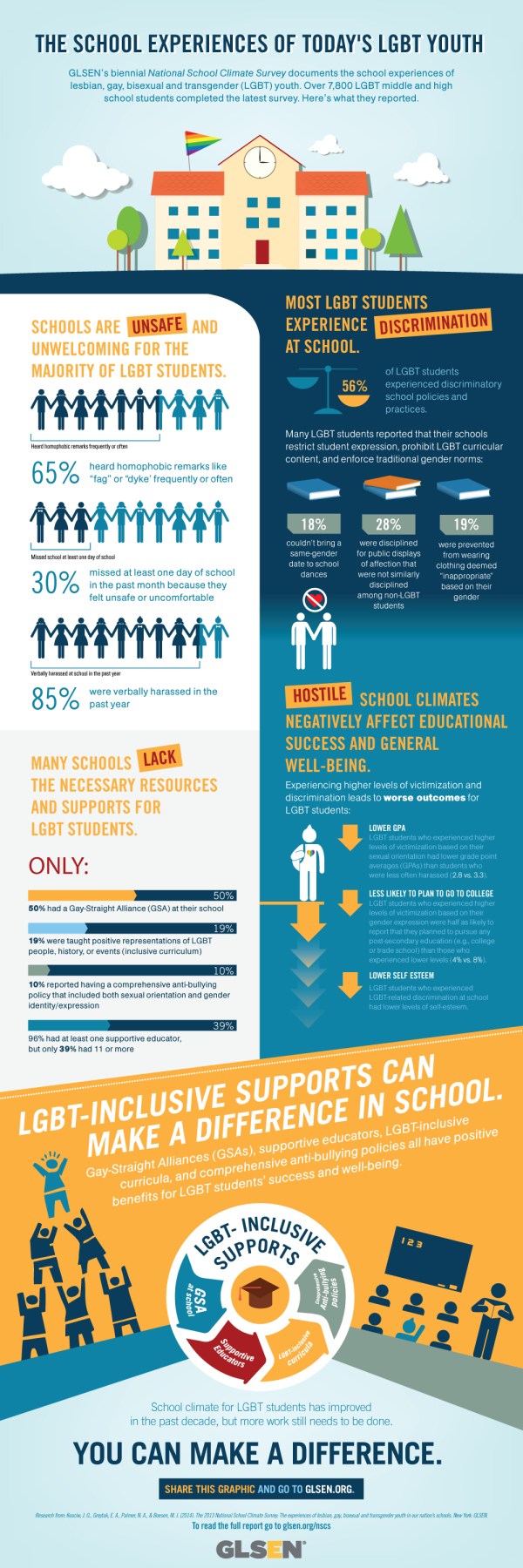The latest iteration of GLSEN’s National School Climate Survey shows LGBT youth are experiencing less harassment and finding more support in schools — but those improvements show circumstances are less bad than before; they’re not necessarily good yet.
The survey, conducted in 2013, included 7,898 students from all 50 states and Washington D.C. A report released today highlights that a majority of LGBT students feel unsafe at school because of their sexuality and more than a third feel unsafe because of their gender expression. Although 96.1 percent of students could identify at least one supportive staff member at school — higher than ever before — even those adults don’t always intervene when they see harassment happen. For some teachers, that silence may stem from job security concerns in the 29 states where employees can be fired for being LGBT. Even though this year’s report is the most positive since the first survey in 1999, much work remains, said GLSEN Executive Director Eliza Byard.
“There’s tremendous progress to be proud of – we see a 20 percentage point drop since 2001 in hearing homophobic comments in schools,” Byard said. “But we’re still talking about 60 percent of students hearing these comments every day when they go to school, and that’s clearly still a crisis.”

via GLSEN.com
These conditions lead to harsh impacts on LGBT students, who have overall lower GPAs than their straight peers and are less likely to be involved in extracurricular activities. Only slightly more than half of students reported there being a Gay Straight Alliance at their school. GLSEN will continue its work with educators, advocates and students to keep improving conditions and educational outcomes for LGBT students, said Joe Kosciw, the chief research and strategy officer at GLSEN. State curriculum policies also need to change, he added.
“We’re seeing an increase of GSAs and the number of supportive educators, but not around curricular inclusion,” Kosciw said. “Students who see positive representation of LGBT history, people and events do better in school, but it’s a minority of students who see any positive information about LGBT people.”
The results of the 2013 and 2011 surveys enable GLSEN to identify strong, positive trends since 2001. Byard said in coming months GLSEN is ramping up its efforts to mobilize advocates in rural communities and the south and focusing on pro-LGBT professional development for educators.
“High school and middle school are hard enough as it is,” Byard said. “To think about the additional barriers facing these students is pretty heartbreaking, and we all need to stand up and do what we can to move them out of the way.”

While I welcome the report, some of its methodology isn’t very impressive (nor does it mention where the respondents were culled from online). First of all, it asks overwhelmingly cisgender survey subjects about hearing terms like “tranny” instead of focusing on the actual populations which hear a term like that used in a derogatory way. Trans feminine spectrum people make up 1.5% of the respondents, which remains a relatively small sample for a national survey. Nor does the survey really go into students who felt compelled to quit high school based on their gender expression or identity. This is, by far, the most vulnerable group of LGBTQ youth, and the group which most often ends up in sex work or highly abusive home situations. While I appreciate there is overlap in many of the experiences of LGBTQ youth, there are certain aspects which are truly unique to gender variant and trans students, especially transfeminine ones, and I wish the survey had keyed in on some of those since they are the ones most often murdered or ending up living on the streets.
Thanks for covering this. I don’t really have anything insightful to add but this is making me think.